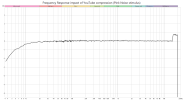- Joined
- Dec 12, 2019
- Messages
- 14,525
- Likes
- 32,686
All y'all know how the hams (amateur radio operators) do it (or, at least, how they used to do it), yes?
A noninductive load (resistor with high power handling capability) -- immersed in a can of oil.

source: https://www.worldradiohistory.com/Archive-Catalogs/Heathkit-Catalogs/Heathkit-Catalog-1977-Fall.pdf pg. 23
The question of steady-state vs. dynamic testing is a longstanding topic of discussion in audio circles. Old folks (i.e., folks even older than I!) probably remember the IHF "music power" standards* - which were (I think) meant as a good-faith attempt to establish repeatable power test criteria that would be relevant to the real world use of a hifi audio amplifier. Later, of course (1974), the US Federal Trade Commission (!) established very rigorous test criteria, with a 30 minute (if memory serves) preconditioning at 1/3 rated power that really pushed a power amplifier's capability. Those were the days of massive (linear, of course -- mostly) power supplies and heat sinks.
________________
* see, e.g., https://www.worldradiohistory.com/Archive-All-Audio/Archive-Audio/60s/Audio-1969-03.pdf pg. 26 of the issue
A noninductive load (resistor with high power handling capability) -- immersed in a can of oil.
source: https://www.worldradiohistory.com/Archive-Catalogs/Heathkit-Catalogs/Heathkit-Catalog-1977-Fall.pdf pg. 23
The question of steady-state vs. dynamic testing is a longstanding topic of discussion in audio circles. Old folks (i.e., folks even older than I!) probably remember the IHF "music power" standards* - which were (I think) meant as a good-faith attempt to establish repeatable power test criteria that would be relevant to the real world use of a hifi audio amplifier. Later, of course (1974), the US Federal Trade Commission (!) established very rigorous test criteria, with a 30 minute (if memory serves) preconditioning at 1/3 rated power that really pushed a power amplifier's capability. Those were the days of massive (linear, of course -- mostly) power supplies and heat sinks.
________________
* see, e.g., https://www.worldradiohistory.com/Archive-All-Audio/Archive-Audio/60s/Audio-1969-03.pdf pg. 26 of the issue
Last edited:


